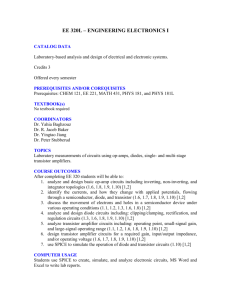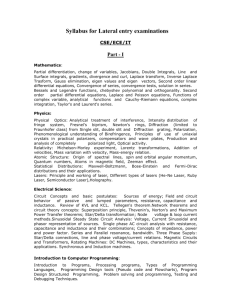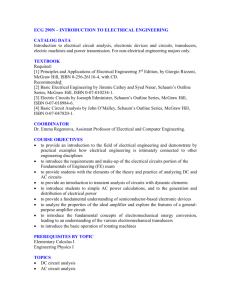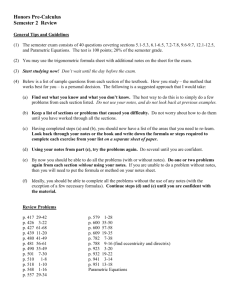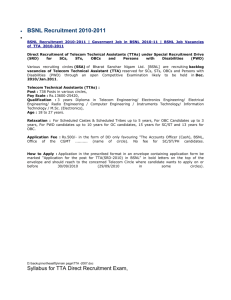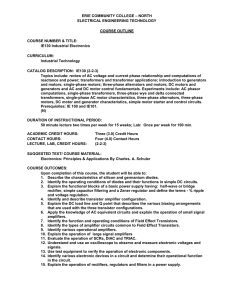3rd Semester Course Outcomes
advertisement
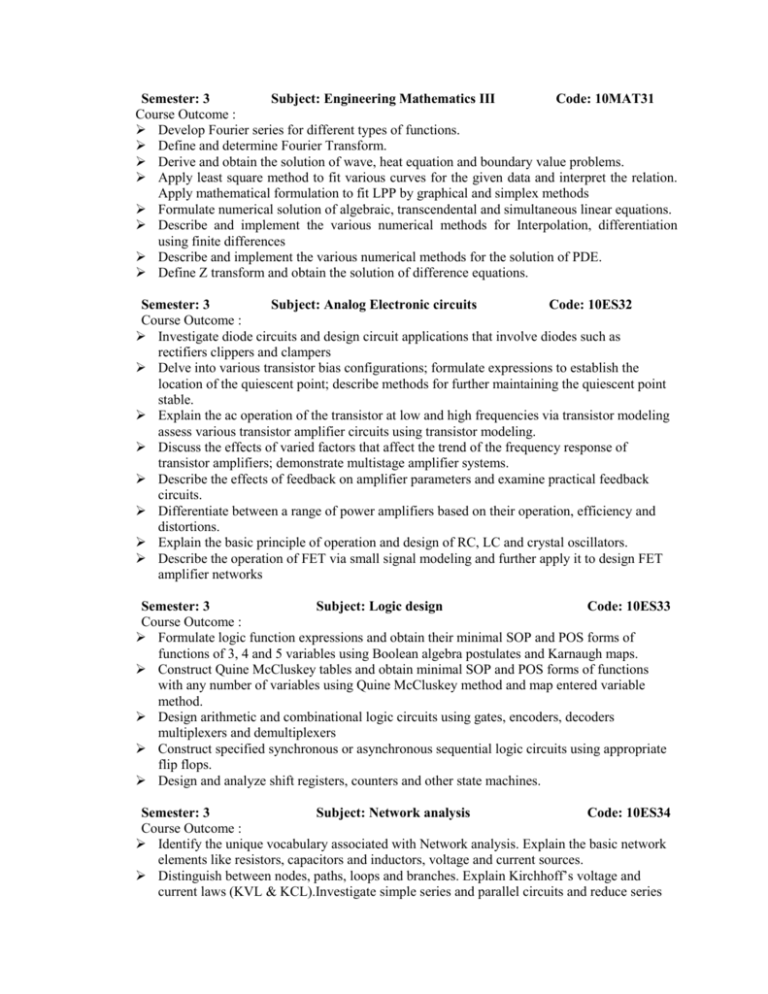
Semester: 3 Subject: Engineering Mathematics III Code: 10MAT31 Course Outcome : Develop Fourier series for different types of functions. Define and determine Fourier Transform. Derive and obtain the solution of wave, heat equation and boundary value problems. Apply least square method to fit various curves for the given data and interpret the relation. Apply mathematical formulation to fit LPP by graphical and simplex methods Formulate numerical solution of algebraic, transcendental and simultaneous linear equations. Describe and implement the various numerical methods for Interpolation, differentiation using finite differences Describe and implement the various numerical methods for the solution of PDE. Define Z transform and obtain the solution of difference equations. Semester: 3 Subject: Analog Electronic circuits Code: 10ES32 Course Outcome : Investigate diode circuits and design circuit applications that involve diodes such as rectifiers clippers and clampers Delve into various transistor bias configurations; formulate expressions to establish the location of the quiescent point; describe methods for further maintaining the quiescent point stable. Explain the ac operation of the transistor at low and high frequencies via transistor modeling assess various transistor amplifier circuits using transistor modeling. Discuss the effects of varied factors that affect the trend of the frequency response of transistor amplifiers; demonstrate multistage amplifier systems. Describe the effects of feedback on amplifier parameters and examine practical feedback circuits. Differentiate between a range of power amplifiers based on their operation, efficiency and distortions. Explain the basic principle of operation and design of RC, LC and crystal oscillators. Describe the operation of FET via small signal modeling and further apply it to design FET amplifier networks Semester: 3 Subject: Logic design Code: 10ES33 Course Outcome : Formulate logic function expressions and obtain their minimal SOP and POS forms of functions of 3, 4 and 5 variables using Boolean algebra postulates and Karnaugh maps. Construct Quine McCluskey tables and obtain minimal SOP and POS forms of functions with any number of variables using Quine McCluskey method and map entered variable method. Design arithmetic and combinational logic circuits using gates, encoders, decoders multiplexers and demultiplexers Construct specified synchronous or asynchronous sequential logic circuits using appropriate flip flops. Design and analyze shift registers, counters and other state machines. Semester: 3 Subject: Network analysis Code: 10ES34 Course Outcome : Identify the unique vocabulary associated with Network analysis. Explain the basic network elements like resistors, capacitors and inductors, voltage and current sources. Distinguish between nodes, paths, loops and branches. Explain Kirchhoff’s voltage and current laws (KVL & KCL).Investigate simple series and parallel circuits and reduce series and parallel connected resistors. Look into an electric circuit to determine the mode of analysis (nodal or mesh). Discuss methods of reducing the circuit. Develop an ability to choose an appropriate analytical method. Illustrate the phenomenon of resonance in both series circuits and parallel circuits and status of complex impedance at resonance. Distinguish between steady state and transient conditions of a network. Discuss mathematical transformations to describe the behavior of networks which are represented using differential equations. Explain the methods to analyze linear networks with a black box approach. Describe methods to measure currents and voltages of a linear network and then characterize such a network with a set of parameters. Predict interaction of the networks with other networks. Semester: 3 Subject: Electronic Instrumentation Code: 10IT35 Course Outcome : Identify and explain the need for accurate measurement of electrical parameters using analog and digital instruments. Compare the performance of various AC and DC voltmeters and select a suitable voltmeter for a given application. Illustrate the measurement of time, frequency and amplitude of a signal on a given oscilloscope. Demonstrate the method to generate the electrical signals using various signal generators. Choose a suitable bridge for a given application . Illustrate the method to measure the resistance, inductance, capacitance using a suitable bridge Categorize and distinguish various transducers and propose a suitable transducer for a real world Application. Demonstrate the method to use display devices in real world applications Semester: 3 Subject: Field Theory Code: 10ES36 Course Outcome : Explain the concept of electromagnetic and give an introduction to vector analysis. State and interpret the experimental law of Coulomb and Gauss’ Law. Distinguish between lumped and distributed parameters. Explain vector operator and Divergence theorem. Propose a concise introduction to the fundamental concepts formulating Maxwell’s equations in both point and integral form. Determine the energy expended in moving a point charge. Develop an expression for the line Integral. Define the Potential and Potential difference and Potential Gradient. Determine the energy density of a point charge, steady current, capacitance. Discuss waves in space and their interaction with media with analogies to wave behavior on transmission lines. State and interpret Biot – Savart law, Ampere’s circuital law and stokes’ theorem along with flux and flux density. Explain scalar and vector magnetic potentials. Explain concepts such as stored energy in magnetic materials, permeability, Magnetic forces & inductance. Describe dielectric and magnetic materials with sections on dielectric polarization and Magnetization. Determine the various boundary conditions for the different materials. Derive Poisson’s and Laplace’s equations from fundamentals and to solve problems on the same. Define polarization of an EM wave. Explain concepts such as wavelength, phase velocity, SWR, reflection for waves in various media. Explain why curl is vector measure of rotation, Explain how total internal reflection occurs and propagation of light inside optical fiber. Assess the relevance of electric and magnetic deflections in a cathode ray tube.
